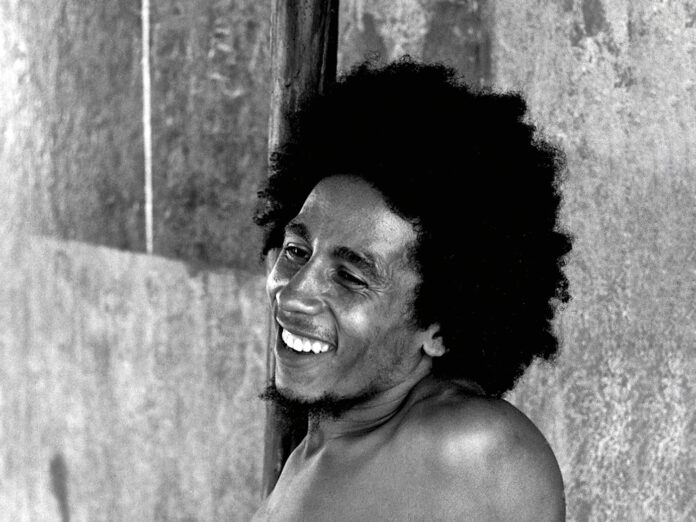Bob Marley, Bunny Wailer and Peter Tosh were in a fix, stranded penniless in London after an ill-judged European venture with Johnny Nash – ludicrously, the Texan crooner was being hyped as 'The King of Reggae' – while Blackwell found himself drawn to the trio's mix of cool and intensity. They had also arrived with perfect timing. The previous week Jimmy Cliff, who Blackwell trusted to break reggae into the mainstream, had walked out in frustration at his career stasis. The Harder They Come, the film destined to make Cliff a star, was endlessly delayed in JA 'soon come' mode. Now here were the Wailers, especially lead singer and songwriter, the charismatic Bob Marley, who might just do the job. He handed the group £4,000 to make an album back home – a low risk bet, but one many thought he would lose.
Bob Marley, Bunny Wailer and Peter Tosh were in a fix, stranded penniless in London after an ill-judged European venture with Johnny Nash – ludicrously, the Texan crooner was being hyped as ‘The King of Reggae’ – while Blackwell found himself drawn to the trio’s mix of cool and intensity. They had also arrived with perfect timing. The previous week Jimmy Cliff, who Blackwell trusted to break reggae into the mainstream, had walked out in frustration at his career stasis. The Harder They Come, the film destined to make Cliff a star, was endlessly delayed in JA ‘soon come’ mode. Now here were the Wailers, especially lead singer and songwriter, the charismatic Bob Marley, who might just do the job. He handed the group £4,000 to make an album back home – a low risk bet, but one many thought he would lose.
The doubters were proved wrong. The Wailers, seasoned veterans of Jamaica’s cut-throat music business, were both ambitious and industrious. They cut deals with studios, recruited gifted players, recycled old numbers and wrote new material. When Marley resurfaced in London with the results, Blackwell was impressed, though he knew more was needed to win over an audience for whom Island meant Traffic, Cat Stevens and Roxy Music. By the time he and Marley had recast the Jamaican tapes, both knew they had a masterpiece on their hands.
From the outset, Catch A Fire was a game-changer, an album that redefined reggae and startled a world that had paid scant attention to Jamaican music or the Wailers’ four previous albums. Its combination of militancy and love song, immaculate harmonies and razor-sharp playing was lethal. Nominally, the triumvirate of the Wailers were still its creators, yet with seven of its nine tracks composed and led by Marley, he became the group’s emblematic focal point.
The opening two tracks assured as much. Led in by a winding, bluesy guitar part by Wayne Perkins, a young Muscle Shoals session player who serendipitously happened to be in Island’s studios, “Concrete Jungle” cast a mood of urban darkness in which “life, sweet life” was nowhere to be found. The song’s title was the nickname for a new housing project in Kingston but could apply to any soulless metropolis. As devastating was “Catch A Fire” itself, with its evocation of slavery and transportation – not subjects much addressed in popular music (though the O’Jays’ “Ship Ahoy” would shortly surface), but one that would soon be commonplace in reggae.
Tosh’s “400 Years” echoed the historical perspective while making a plea for “the youths of today” – as elsewhere, Jamaica was in the midst of a post-WW2 youth boom – and his belligerent, rumbling baritone was further present on “Stop That Train” with its protest that “some are living big, most is living small”.
Bringing sweetness and light into the mix came the languorous, seductive love call of “Stir It Up”, a recycled JA hit from 1967 that had recently supplied a hit for Johnny Nash. Here it’s reclaimed for its creator, with the sweeping synth of ‘Rabbit’ Bundrick (then playing with Free) adding novelty and drama. “Baby We Got A Date” extended the romantic mood (most of Marley’s hits would be love songs) while “Kinky Reggae” supplied a rude counterpoint while also flying the flag for reggae itself.
“No More Trouble” and “Midnight Ravers” returned to darker strains, the former repeating the call for love (universal rather than romantic) against a brooding backdrop, while the latter added an almost apocalyptic flavour with visions of “ten thousand chariots” and “riders without faces” that might have been plucked from Revelation.
The album was promoted cannily by Island, with a special show at London’s Speakeasy, the watering hole for elite rockerati, and 20,000 copies packaged in a lavish cover in the shape of a zippo lighter. Music aside, Catch A Fire marked the emergence of a self-contained reggae group that wrote, played and sang its own material and could tour it – a rock commonplace that was a necessity if the Wailers were to win a mainstream audience, white or black. Reggae’s musical economy, built on hit singles, sound systems and backing bands, was transformed, both in Jamaica and in the UK. The live material here, including previously unheard London performances, shows a fledgling outfit, rich in vocals and songs, and with an unfaltering rhythm section, but without the full sound that a couple of years later would help make Marley the third world’s first superstar.
EXTRAS 9/10: Available as a 3CD set or 3LP + 12”. Both sets include Live From The Paris Theatre London, and Sessions, plus three previously unreleased live tracks from the Sundown Theatre, Edmonton, London. There’s also a booklet with photos, liner notes by Chris Salewicz, press cuttings and more, and the 12” features an etched Zippo lighter.



